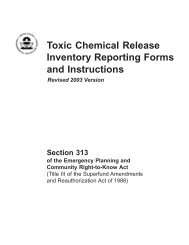Ergonomic Guidelines for Nursing Homes - Seton Resource Center
Ergonomic Guidelines for Nursing Homes - Seton Resource Center
Ergonomic Guidelines for Nursing Homes - Seton Resource Center
You also want an ePaper? Increase the reach of your titles
YUMPU automatically turns print PDFs into web optimized ePapers that Google loves.
Section I. Introduction<br />
<strong>Nursing</strong> homes that have implemented injury prevention ef<strong>for</strong>ts focusing on<br />
resident lifting and repositioning methods have achieved considerable success in reducing<br />
work-related injuries and associated workers' compensation costs. Providing a safer and<br />
more com<strong>for</strong>table work environment has also resulted in additional benefits <strong>for</strong> some<br />
facilities, including reduced staff turnover and associated training and administrative<br />
costs, reduced absenteeism, increased productivity, improved employee morale, and<br />
increased resident com<strong>for</strong>t. These guidelines provide recommendations <strong>for</strong> employers to<br />
help them reduce the number and severity of work-related musculoskeletal disorders in<br />
their facilities using methods that have been found to be successful in the nursing home<br />
environment.<br />
Wyandot County <strong>Nursing</strong> Home in Upper Sandusky, Ohio, has implemented a policy<br />
of per<strong>for</strong>ming all assisted resident transfers with mechanical lifts, and has purchased<br />
electrically adjustable beds. According to Wyandot no back injuries from resident<br />
lifting have occurred in over five years. The nursing home also reported that<br />
workers’ compensation costs have declined from an average of almost $140,000 per<br />
year to less than $4,000 per year, reduced absenteeism and overtime have resulted in<br />
annual savings of approximately $55,000, and a reduction in costs associated with<br />
staff turnover has saved an additional $125,000 (1). (see Reference List)<br />
Providing care to nursing home residents is physically demanding work. <strong>Nursing</strong><br />
home residents often require assistance to walk, bathe, or per<strong>for</strong>m other normal daily<br />
activities. In some cases residents are totally dependent upon caregivers <strong>for</strong> mobility.<br />
Manual lifting and other tasks involving the repositioning of residents are associated with<br />
an increased risk of pain and injury to caregivers, particularly to the back (2, 3). These<br />
tasks can entail high physical demands due to the large amount of weight<br />
involved, awkward postures that may result from leaning over a bed or<br />
working in a confined area, shifting of weight that may occur if a resident<br />
loses balance or strength while moving, and many other factors. The risk<br />
factors that workers in nursing homes face include:<br />
• Force – the amount of physical ef<strong>for</strong>t required to per<strong>for</strong>m a task<br />
(such as heavy lifting) or to maintain control of equipment or tools;<br />
• Repetition – per<strong>for</strong>ming the same motion or series of motions<br />
continually or frequently; and<br />
• Awkward postures – assuming positions that place stress on the<br />
body, such as reaching above shoulder height, kneeling, squatting,<br />
leaning over a bed, or twisting the torso while lifting (3).<br />
Excessive exposure to these risk factors can result in a variety of<br />
disorders in affected workers (3, 5). These conditions are collectively<br />
After implementing a<br />
program designed to<br />
eliminate manual lifting<br />
of residents, Schoellkopf<br />
Health <strong>Center</strong> in<br />
Niagara Falls, New<br />
York, reported a<br />
downward trend in the<br />
number and severity of<br />
injuries, with lost<br />
workdays dropping from<br />
364 to 52, light duty days<br />
dropping from 253 to 25,<br />
and workers’<br />
compensation losses<br />
falling from $84,533 to<br />
$6,983 annually (4).<br />
4

















